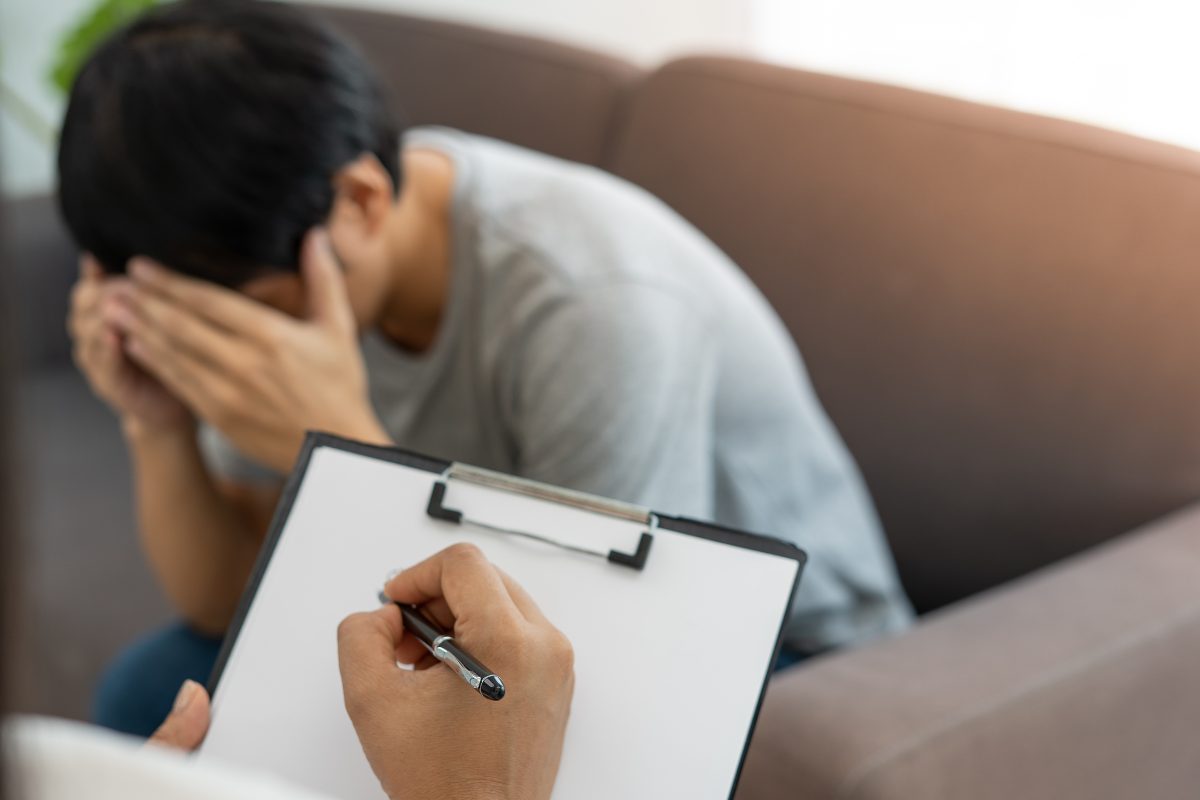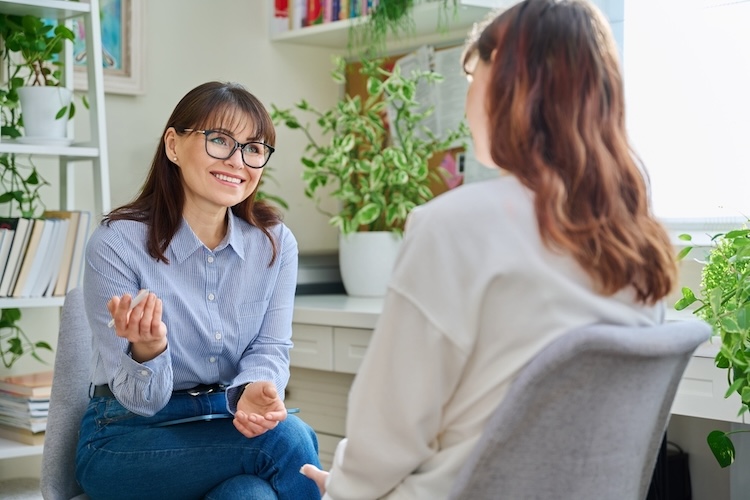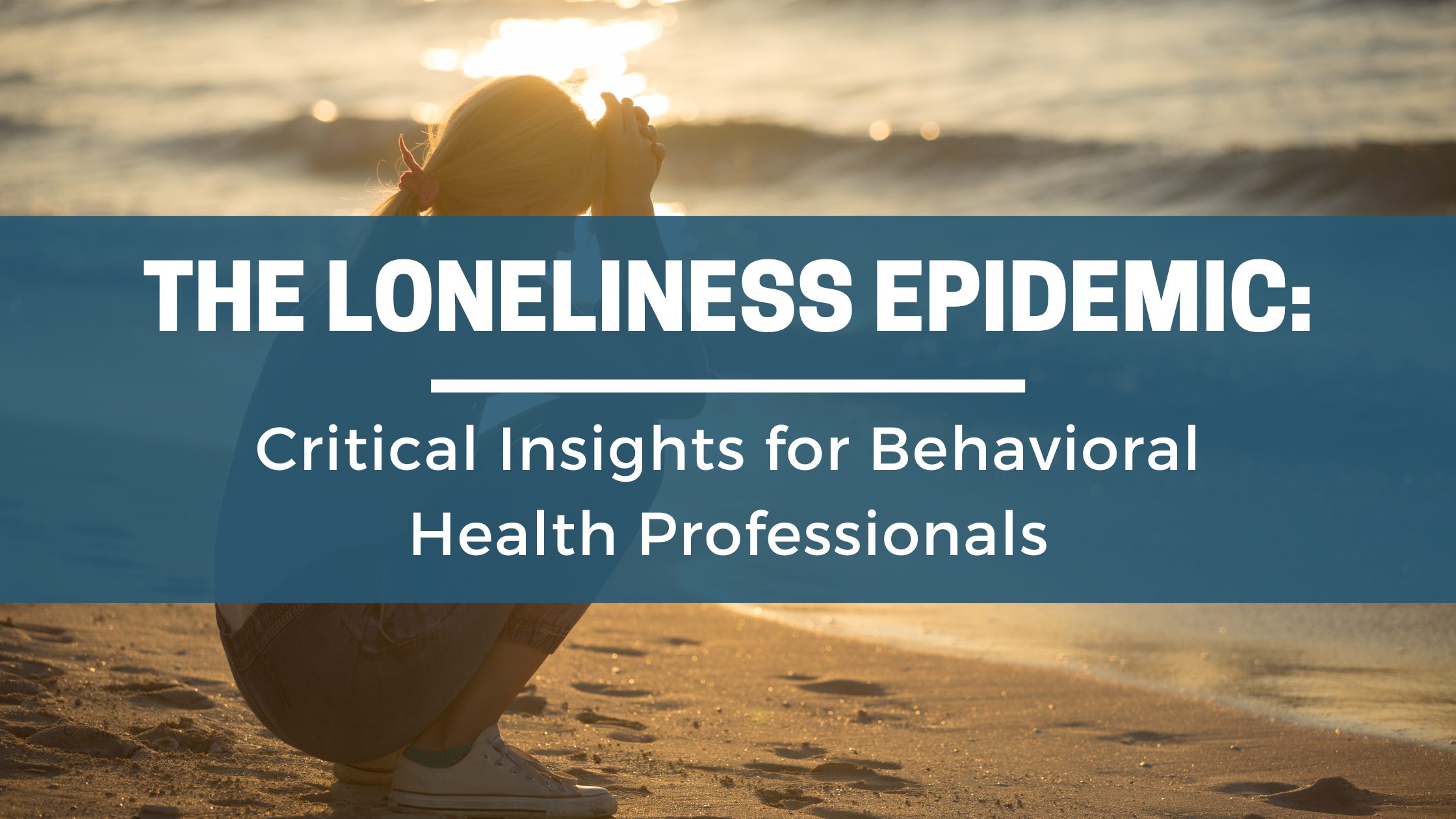
The Loneliness Epidemic: Critical Insights for Behavioral Health Professionals
In recent years, the loneliness epidemic in the United States, and particularly within younger generations has been on the rise, causing a heightened attention to this issue from healthcare practitioners, mental healthcare workers, and epidemiologists. Loneliness has been shown to shorten an individual’s life by roughly 15 years [1]. This shortened life expectancy has been attributed to conditions such as, but not limited to, heart disease, stroke, dementia, type 2 diabetes, and suicide [1].
As the focus on, and prevalence of loneliness becomes more common, we want to share data and interventions about the loneliness epidemic that every clinician should know.
Free Webinar:
Join us for an insightful webinar delving into the pressing issue of loneliness, especially prevalent among younger generations in the United States. This growing concern has garnered increased attention from healthcare professionals, mental health experts, and epidemiologists alike. For individuals healing from alcohol abuse, drug addiction, eating disorders, and gambling, loneliness can be detrimental to a recovery journey.
In this engaging conversation, we'll hear from Kaylee Kron, LMSW (she/her), and Eric Dorsa, a National Mental Health Advocate (they/them). They will share their personal journey through recovery, shedding light on the significant challenges posed by loneliness and how fostering social connections plays a pivotal role in sustaining a recovery path. Don't miss this powerful discussion on navigating loneliness and building resilience in the journey towards healing.
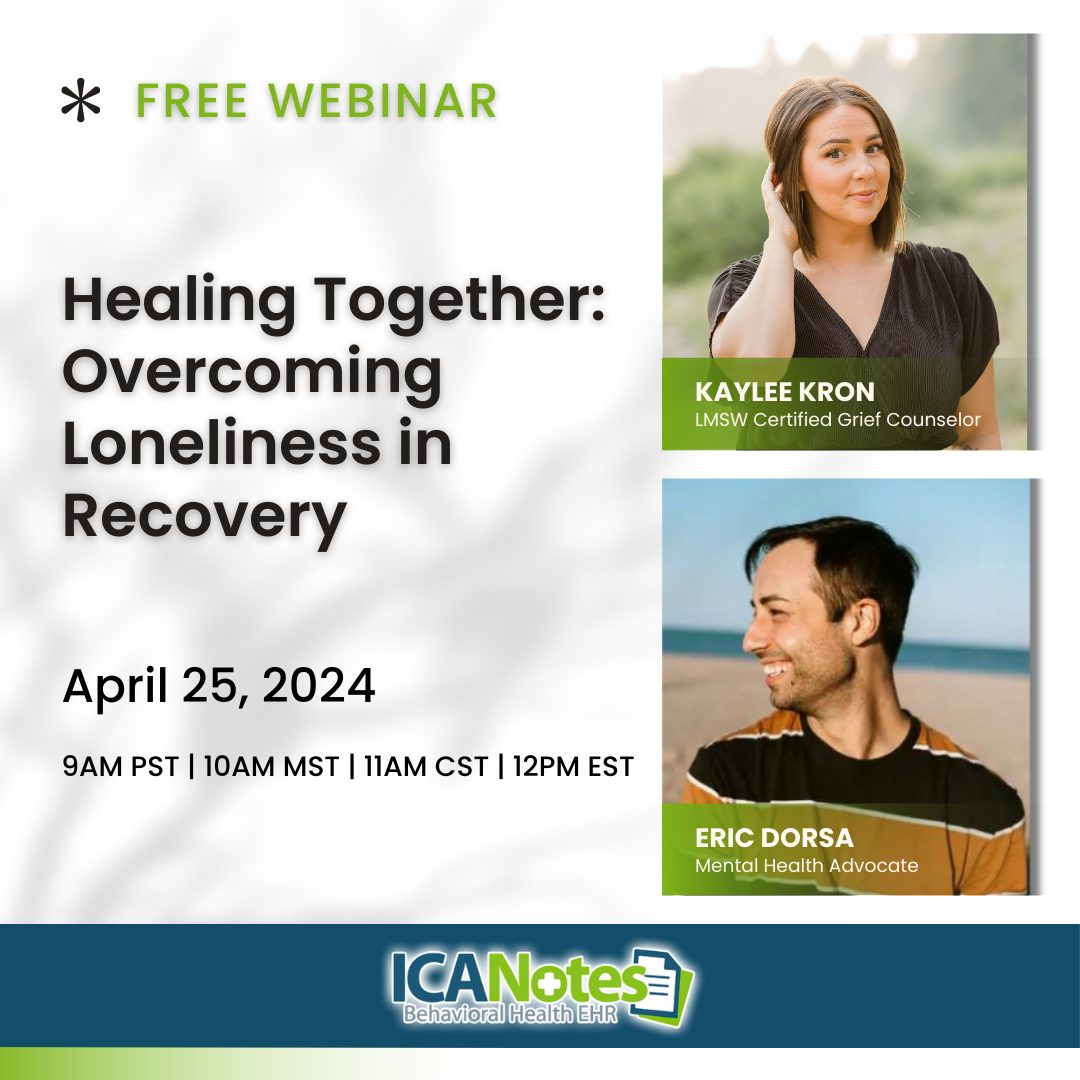
Epidemic of Loneliness
According to the U.S. Surgeon General, the United States is facing an epidemic of loneliness and isolation, which has been shown to have profound and lasting consequences on our mental and physical health. In fact, according to data collected within the 2023 advisory, social isolation results in premature death by 26%, which is equivalent to smoking 15 cigarettes a day [1]. Additionally, within this same research study, it was found that only 39% of Americans feel deeply connected, creating a majority of our population lacking connection which is a key indicator of loneliness and isolation. According to a recent study out of San Diego, men and women experience loneliness at equal levels [3].
Clinicians working within the mental health space should be aware of this prevalence while working with clients, and be mindful to assess for loneliness and social isolation as a foundational step within initial assessments. Throughout this blog, we will establish the need for intervention for loneliness and social isolation while zooming into diverse communities at a high risk for loneliness, identifying signs and symptoms, and discussing clinical strategies for addressing this issue.
Defining Loneliness
“Loneliness is defined as a subjective distressing experience that results from perceived isolation or inadequate meaningful connections, where inadequate refers to the discrepancy or unmet need between an individual’s preferred and actual experience.” -The U.S. Surgeon General’s Advisory on the Healing Effects of Social Connection and Community [1]
Simply witnessing someone on their own, or not accompanied by others does not necessarily equate to loneliness. When defining loneliness, it is important to stress that being “alone” or in “solitude” differs based on the individual’s perception of their time spent without the company or connection of others [1]. The primary differentiator is that individuals who spend time “alone” or in “solitude” do not feel consistent loneliness, social isolation, or a lack of connection. Pulling apart the experience of loneliness from being alone, we typically see the following:
- Actual social connectedness is less than the desired amount of social connection of an individual;
- Lacking social participation, connection, and cohesion;
- When an individual reaches out for support for loneliness, they are unsuccessful.
Interestingly, there is a primary difference between loneliness and social isolation that bears noting. Social isolation is defined as having limited social connections, relationships, roles, and interactions, whereas loneliness is an internal state that is subjective to an individual’s perception [1].
Stages of Loneliness
While loneliness is a feeling all individuals are susceptible to at one point or another in life, research shows that there are three primary life stages in which we are most at risk for loneliness: our late 20s, mid 50s, and early 80s. When broken down, each of these stages, ostensibly, bring about a set of challenges and life changes that can be supported through strong social supports, and negatively impacted by a lack of connection [3].
In our 20s, we are often faced with decisions related to life trajectory. A well-connected person will have many opportunities to discuss these decisions with others, many times, right alongside peers within a similar age group. This ability to view others’ decisions, talk through our own, and walk the journey into adulthood together is a catalyst into further social connectedness. Conversely, individuals who begin this stage of life with low levels of social connection and are generally more isolated have fewer opportunities for similar processing and companionship.
As we reach our 50s, life shifts tend to occur again as we begin to see health issues, family members passing, and our family structure can begin to look different as children age out of the home. Lastly, in our 80s, our social connections have aged along with us, creating experiences of grief and loss more prevalently. As life shifts and social networks change, stages of loneliness continue to create barriers to deep social connection.
Effects of Loneliness
As previously noted, the effects of loneliness and social isolation has both physical and mental consequences. According to the 2023 Surgeon General Report, loneliness and social isolation can increase an individual’s risk of premature death by 26%, and has been linked to heart disease, stroke, anxiety, depression, dementia, respiratory illnesses, and suicide [1]. These effects of loneliness create lasting health-related issues that impact a person’s quality of life and physical health, which in turn, creates even more barriers to engaging in activities that combat loneliness and social isolation.
Loneliness and Suicide
Loneliness has been linked to suicidal ideation and an elevated risk for suicidal behavior. In 2023, The National Library of Medicine released a review about the correlation between suicide, living alone, and loneliness and found that addressing loneliness in suicidal individuals can have a large and lasting impact on future suicidal ideation, passive suicidal ideation, and suicidal plans and attempts [2]. These findings were confirmed regardless of a present mental health condition, showing that independently that an individual’s subjective experience with loneliness carries a risk of suicide. However, a present mental health diagnosis raises suicide risk.
Interestingly, in this same study it was found that individuals who report loneliness also do not engage in seeking out supportive interventions as opposed to their less lonely counterparts. Throughout the study, factors such as the presence of anxiety, depression, and living alone all impact one’s overall risk for suicidal ideation, passive suicidal ideation, and suicidal behaviors [2].
Loneliness Epidemic High Risk Groups
While loneliness can impact anyone, many groups are seen as “high risk” for loneliness, including individuals in underrepresented and marginalized populations as well as individuals in lower socio-economic brackets, and young adults.
Hispanic as well as Black/African American communities showed a marked increase in reported loneliness. Based on research from The Cigna Group, these communities showed loneliness across 68 – 75% as opposed to the standard 58% across all populations. Of those who earn less than $50,000 a year, 68% reported loneliness. Interestingly, this research also reports that 72% individuals who are on Medicaid are classified as lonely. Young adults report feeling lonely at twice the rate of older adults, at 79% [4].
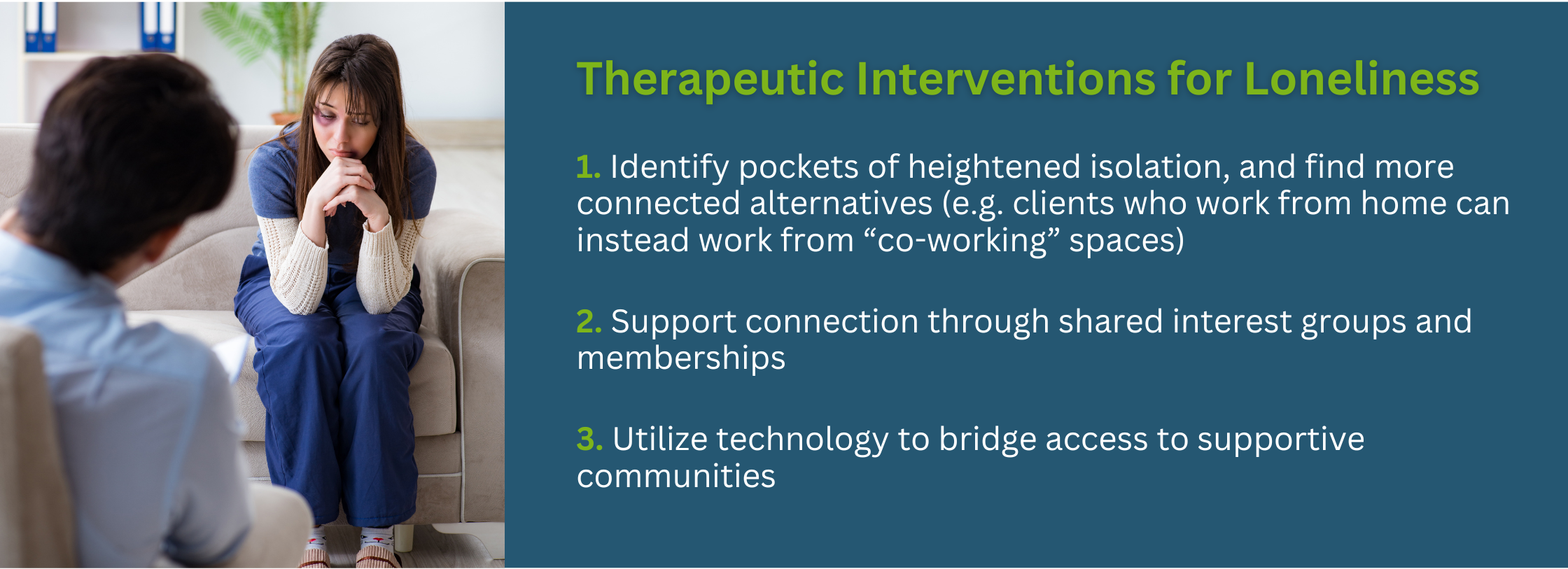
Therapeutic Interventions for Loneliness
Combatting the loneliness epidemic and social isolation is not something that can be done individually, but rather within systems and communities that support connection. For many, this is not accessible and, in these cases, therapeutic intervention may be warranted. As we dive deeper into defining loneliness, we find that the intensity that one feels lonely is subjective based on their desire for social connection. With this in mind, it is important to tailor interventions to clients based on their personal experience rather than a standard practice for all.
Facilitating connection and support are a primary intervention when supporting individuals who report feelings of loneliness. While there are many opportunities to encourage connection, here are a few primary interventions to consider:
- Identify pockets of heightened isolation, and find more connected alternatives (e.g. clients who work from home can instead work from “co-working” spaces)
- Support connection through shared interest groups and memberships
- Utilize technology to bridge access to supportive communities
Treatment Plan for Social Isolation
As a mental health professional, thoroughly understanding loneliness can elevate your work with clients. Loneliness is an incredibly subjective experience that is unique from person to person making it vital to keep all sessions with your clients well-documented so you can monitor their progression and determine if they need clinical intervention or treatment adjustments.
With ICANotes, you can equip yourself with the behavioral health tools and templates you need to keep your session notes and treatment plans legible, well-organized, and ready for sharing with other professionals if needed. Our clinically robust and intuitive EHR software can reduce the time you spend on documentation, help you maintain compliance, and empower you to deliver more comprehensive care. Contact us today for more information or request a free trial online.
Addressing the Epidemic of Loneliness
Loneliness is an issue facing so many individuals that may require formal, therapeutic intervention. When loneliness is addressed, patients and client’s risk for anxiety, depression, and suicide reduce, creating space for a more connected and fulfilling life.
About the Author

Kaylee Kron, LMSW
For the past decade, Kaylee has worked to change the way we understand, process, and support grief.
As a grief counselor at a local nonprofit hospice, Kaylee had the privilege of walking alongside grievers as a companion; uplifting each individual as the expert of their own story. Each person she met during this time further confirmed to her that we grieve so much more than losses suffered through the death of a lived one. In each and every individual session, family grief session, support group, and memorial event, Kaylee found that an individual's life is colored by grief in all forms - relationships, roles, hopes for the future, and changes to the story they believed about what their life would look like.
Today, Kaylee continues her work as an author, public speaker, and community organizer of large scale events that create space for each attendee to look back at life most difficult moments, and the pain they felt, and say "that is grief".
Kaylee has been featured in articles, podcasts, community trainings, online courses, and magazines giving voice to feelings of grief and expanding our community's understanding of the many losses that cause grief throughout our lives.
Kaylee holds a masters of social work and is a certified grief counselor through the American Institute for Healthcare Professionals.
Sources




